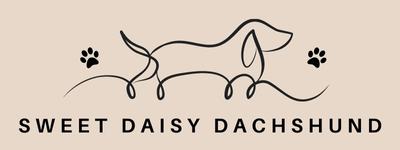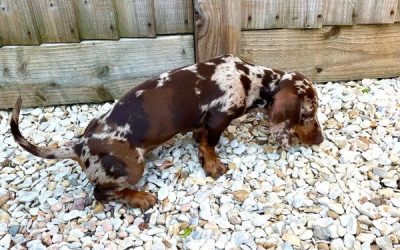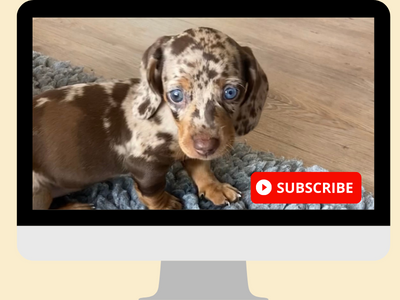At 10 weeks old, a doxie puppy is at an exciting stage of their development. They are much more active and their personalities are becoming more apparent. So how is our dachshund puppy doing at 10 weeks old? Keep on reading as we are excited to tell you all about her development at this stage.

How Is Our Dachshund Puppy Doing At 10 Weeks Old – Table Of Content:
- Our puppy is growing more confident
- Is our puppy a fussy eater?
- Socialising our puppy is a big deal for us
- How is the training going?
- Crate training progress and our tips for you
- Introducing our puppy to grooming
How Is Our Dachshund Puppy Doing At 10 Weeks Old
The second week with our dachshund puppy has been full of energy, laughter and tons of love. And definitely easier than the first week! We quickly realised that while Daisy may be small, she has a big personality and boundless energy. Watching her learn, explore and develop is a truly wonderful experience and it’s been exciting to witness her growth and development each day.
Our puppy is growing more confident
First thing you may notice about your puppy as you enter into the second week with them is how much their confidence grows day by day. Daisy’s first week with us was all about making her feel secure and comfortable in her new home. As soon as she had reached that milestone, we started seeing changes in her personality but in a positive way. As her confidence grew, she was more daring and adventurous around us and our home, but also easier to train and socialise.
But beware because once your puppy starts gaining more confidence the more mischief they will get up to! They will be testing the boundaries and it is up to you to set the ground rules and start behaviour training from there onwards. Daisy didn’t show any interest in our personal items at all the first week but it was just a matter of time before she felt brave enough to start chewing our slippers. 🙂

Is our puppy a fussy eater?
We mentioned earlier that the second week with our puppy had been much easier but that’s not entirely true when it came to feeding. Although we were prepared for Daisy not having much appetite the first few days, we didn’t expect her to be off food for almost entire two weeks. We fed her the same kibble she was used to from the breeder’s and followed the same feeding routine but Daisy barely touched her food the first week.
Half way through the second week, we made a quick decision to change to raw food. Having had done lots of research about the benefits of feeding raw diet prior to picking up Daisy from her breeder, we were already decided to go down that path anyway. Preferably we would have waited until she was a bit more settled before changing her diet. But since she didn’t seem so interested in eating her kibble we had nothing to lose.

It took Daisy a good couple of days on the raw diet before she found her appetite again and now she gobbles up all her food within minutes. To our suprise she even put on weight despite of not eating well for about a week and a half.
We would recommend starting with chicken puppy complete raw that is much kinder to their tummy than other proteins. And if you can find a brand that sells chicken mixed with raw green tripe than that would be even better. Raw green tripe is benefitial to your puppy in many ways but it’s also packed with natural probiotics and digestive enzymes that will help with the transition to raw diet. It may be a bit smelly but it is irresistible to even the fussiest of dogs.
We started with Raw Puppy Food by ProDog, which is a UK based award winning brand that meets strict FEDIAF standars and guidelines and sells chicken with raw green tripe. We can now watch Daisy thrive knowing that she eats healthy BARF diet using fresh and ethically sourced local ingredients.
Socialising our puppy is a big deal for us
If you read our previous diary entry Our dachshund puppy’s first week at home, then you already know that socialising Daisy on daily basis is a big deal for us. It is super important to start socialising your puppy during the first week at home because you have a short ‘socialising window’ that usually lasts up to 12 weeks of age. Of course, you need to continue to socialise your puppy after this age but the exposure to different environments and situations is the most successful during this ‘window’.
Not only did we continue to take Daisy outdoors twice a day during her second week with us, but we also exposed her to different materials to touch and walk on, and to different smells and noises around the home. We slowly introduced her to our hoover, mop and even a hair dryer and she is now comfortable and pretty relaxed when we dry our hair or hoover around her.

When outdoors, we still had to carry Daisy in her carrier but she received her last core vaccination at the beginning of the second week, which means she will be able to walk on the ground and socialise with other dogs soon. In the meantime, we carried on taking Daisy to different parks but also other environments such as shops and cafes. Just to give you an idea, these are all the places we visited during the first two weeks:
- 3 different parks
- 2 different cafes
- a garden centre
- a pet shop
- a pharmacy
- a bus station
- a bicycle shop
- a restaurant
- an underground/subway station
- a dry cleaners shop
- went for a walk by a canal
- went for a car drive 3 times
We know it seems a lot but socialising your puppy on regular basis is a must as it allows them to become comfortable with different environments and situations and will set the foundation for their behaviors later in life.


How is the training going?
So how is our dachshund puppy doing at 10 weeks old when it comes to training? You already know that potty and crate training is a must from the very first day as we keep going on and on about it. But how about training positive behaviour and different commands? We did start some behaviour training during Daisy’s first week with us but we didn’t put much emphasis on training her lots of commands. We felt it wasn’t neccessary to overwhelm her with lots of training at that stage so we trained her name association plus 3 commands to start with: sit, stay and drop it.
During the second week, we continued to improve the skills she had learned already plus added a couple of new commands: down and spin. Not to mention a constant behaviour training as she started to chew and bite a lot more with her growing confidence.
Because Daisy was still not eating well and wasn’t so keen on treats either, all of our training was done using lots of praise and her toys. So don’t feel you have to keep offering tons of treats to your puppy during their training stage. Lots of puppies prefer cuddles and praise as a ‘higher value’ reward.
Also, we must not forget to give you a quick update on potty training. If you remember, last time we mentioned that we take Daisy out each time she wakes up, eats and plays and every 30 minutes or so in between. We continued with this approach during the second week and although Daisy still had some accidents, they were rare. We also learned to read the signs she needs to go really well and she again rang the bell by the door twice when she needed a poo. What a clever girl! 🙂
To learn more about how to potty train your puppy, make sure to read our article on How to potty train your dachshund puppy easily and fast!
Crate training progress and our tips for you
Crate training Daisy has been much easier so far then expected! We do follow a strict and very consistent routine, which works very well for both Daisy and us.
During her first week with us, Daisy used to wake up a few times a night with two potty breaks. About half way through the second week, she started to sleep through the night without waking up or without asking to go out for a potty break (hurray)! 🙂 She also started having a couple of naps in her crate during day time.

To help you with crate training, we have summarised a few tips and tricks below:
- start feeding and playing with your puppy in their crate with the gate open on day one
- let them sleep in the crate with the gate open and you next to it during the day time on day one
- put your puppy to sleep at set time every night
- don’t feed your puppy water or food 2-3 hours before bedtime
- don’t play with or exercise your puppy straight before bedtime
- placing these inside the crate really helps: ‘hearbeat’ soft toy, a blanket that smells of your puppy’s mum or clothes that smell of you
- cover the crate with a blanket
- you can also play calming music
- don’t leave your puppy alone at night – place the crate in your bedroom or sleep next to it downstairs for a couple of weeks
- do not take your puppy out of the crate every time they cry
- instead sit next to the crate, put your hand or finger inside and comfort your puppy until they calm down; don’t let them cry without comforting them though
- it shouldn’t take long for your puppy to calm down while you comfort them but if they can’t settle it means they need a potty break
- your puppy will need 1 to 2 potty breaks a night to start with
As with any type of puppy training, consistency and patience is key if you want to succeed. As long as you don’t leave your puppy alone and are always there to comfort them and reassure them to make them feel safe, they will soon feel more comfortable sleeping in their crate.
How Is Our Dachshund Puppy Doing At 10 Weeks Old – Watch Us On YouTube
How is our dachshund puppy doing at 10 weeks old? If you would like to see what mischief Daisy got up to during her second week at home then make sure to watch our video below.
Introducing our puppy to grooming
Once your puppy is well settled and comfortable around you, it’s time to start introducing them to grooming. There is no rush to bath them or comb their hair straight away. However, they need to get accustomed to grooming utensils and being touched around the more sensitive parts of their body, such as their ears, eyes or paws.
We let Daisy sniff the grooming utensils and products first and then rewarded her if she stayed calm when we touched her with the brush or nail clippers. We also started to clean her eyes and ears, again rewarding her with lots of praise when she stayed calm or behaved well. Fortunately she seems to enjoy having her ears cleaned especially if we let her chew her toys at the same time.
The next task on our to-do list was to start preparing Daisy for her bathtime so she would find it more relaxing. This is a slow step by step process that we didn’t want to rush because we want her to enjoy bathtimes in the future.
She was quite scared when inside the bathroom so we started with the basics. Scaterring some treats all over the bathroom floor and leaving the water tap running is a good starting point. This way your puppy will get used to the scary ‘echoey’ sounds of the bathroom.
If you would like to find out how we progressed with the bathtime training then make sure to read out next diary entry. We will also talk about how to prevent biting and chewing in more detail so stay tuned! 🙂
How Is Our Dachshund Puppy Doing At 10 Weeks Old – Let Us Know What You Think!
Let us know if you found this article helpful in the comments below. We love to hear your feedback!
Join ‘Dachshund Buddies’ On Facebook!
Join our ‘Dachshund Buddies’ Facebook community dedicated to all things dachshund! It is a great way to connect with other dachshund owners and enthusiasts, who are always there to help each other. You will find plenty of interesting conversations and valuable tips, tricks and advice to help you care for your loving doxie.









0 Comments